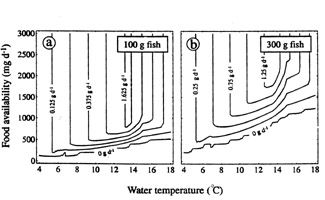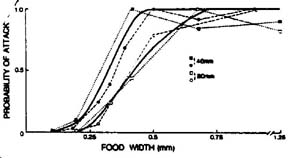Thermodynamics play an extremely important role in the behavior and health of fish. Both water temperature and food sources (energy) in the system effect fish bioenergetics in significant ways, as we will see here.
Water temperature strongly effects the metabolism of fish. A fish's metabolism will be optimized at some intermediate temperature between too hot and too cold, depending on the species. Therefore, the energy gained from the caloric content of prey items will depend highly on temperature. The figure below is a little difficult to interpret, but not that bad if you're familiar with topographic maps. The contours are growth contours, showing how the growth of a fish will vary with different levels of food and water temperature. There is greater growth at the "higher" contours. For example, in the graph for the 100 gram fish (trout), optimal growth occurs somewhere around 13 degrees Celsius when there is unlimited food. The vertical lines occur because there is a maximum amount of food that a fish can consume, even when it is given unlimited food.

Figure fom Hughes (1999)
A little bit easier way to conceptualize the important point in the figure above is shown in the figure below. Basically, at a constant amount of food, growth rate will increase with increasing temperature to a certain threshold, and then it will begin to decrease. The optimal temperature for the fish in the example below (a bluegill) is around 30 degrees Celsius, much higher than the optimal temperature for the trout in the example above.

Figure from Crowder and Magnuson (1980)
The caloric content of food that is available also plays a prominent role in effecting the net rate of energy intake. For example, some species of drifting invertebrates have a much higher caloric value than other species. Also, for any given species, a larger-bodied organism will have a higher caloric value than smaller-bodied organisms. The preference for prey with higher caloric content is demonstrated in the figure below, showing how fish have a greater probability of attacking larger prey. Of course, this is within the constraints of some maximum size that they would be able to consume. Nonetheless, bioenergetics is at work here in effecting the behavior of fish.

Figure from Dunbrack and Dill (1983)